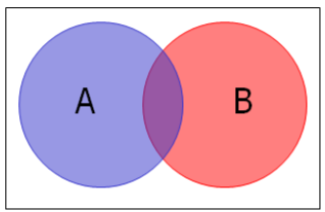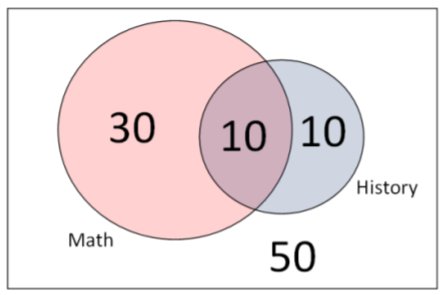5.5: Joint Probability and Additive Rule
- Page ID
- 20881
Two or more events can be combined into joint events by using “or” statements or “and” statements.

The Union of two events A and B is that either event A or B occurs, or both; (the blue, red and purple parts of the Venn diagram shown to the right).
The Intersection of two events A and B is that both events A and B occur; (the purple overlap of the Venn diagram shown to the right).
Marginal Probability means the probability of a single event occurring.
Joint Probability means the probability of the union or intersection of multiple events occurring.
Example: Student courses

In a group of 100 students, a total of 40 students take Math, a total of 20 students take History, and 10 students take both Math and History. (Note that these 10 students were already counted twice as being Math students and History students). Find the marginal and joint probabilities.
Solution
Marginal Probabilities:
P(Math) = 40/100 = 0.4
P(History) = 20/100 = 0.2
Joint Probabilities:
P(Math and History) = 10/100 = 0.1 (this is the intersection of the two events)
P(Math or History) = 50/100 = 0.5 (this is the union of the two events)
We can make a rule for relating joint and marginal probabilities but noticing that we are double counting the outcomes in the intersection of two events when combining marginal probabilities from event each event. This is called the Additive Rule.
The Additive Rule for Probability
\[P(A \text { or } B)=P(A)+P(B)-P(A \text { and } B) \nonumber \]
Example: Student courses
Calculate the probability that a student is taking Math or History using the additive rule. Compare to the direct calculation in the prior example.
Solution
P(Math or History) = P(Math) + P(History) – P(Math or History)
P(Math or History) = 0.4 + 0.2 – 0.1 = 0.5
Mutually Exclusive means that two events A, B cannot both occur. In this case, the intersection of two events has no possible outcomes.
The Additive Rule for Mutually Exclusive Events
\[P(A \text { or } B)=P(A)+P(B) \nonumber \]
Example: Spanish class
500 students at a community college are taking Spanish 1A in the Fall Quarter this year. 32 students are in Section 11 and 30 students are in Section 12. Find the probability that a Spanish 1A student is in Sections 11 or Section 12.
Solution
Since students cannot be in two sections of the same class, the events Section 11 and Section 12 are mutually exclusive.
P(Sec 11 or 12) = P(Sec 11) + P(Sec 12) = 32/500 + 30 /500 = 62/500 = 0.124


